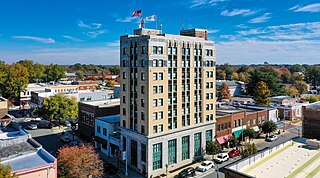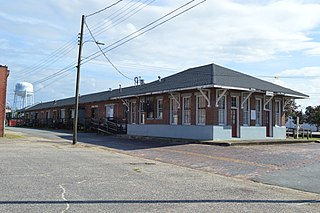
Warren County is a county located in the northeastern Piedmont region of the U.S. state of North Carolina, on the northern border with Virginia, made famous for a landfill and birthplace of the environmental justice movement. As of the 2020 census, its population was 18,642. Its county seat is Warrenton. It was a center of tobacco and cotton plantations, education, and later textile mills.

Vance County is a county located in the U.S. state of North Carolina. As of the 2020 census, the population was 42,578. Its county seat is Henderson.

Granville County is a county located on the northern border of the U.S. state of North Carolina. As of the 2020 census, the population was 60,992. Its county seat is Oxford. The county has access to Kerr Lake and Falls Lake and is part of the Roanoke, Tar and Neuse River watersheds.

Burlington is a city in Alamance and Guilford counties in the U.S. state of North Carolina. It is the principal city of the Burlington, NC Metropolitan Statistical Area, which encompasses all of Alamance County, in which most of the city is located, and is a part of the Greensboro–Winston-Salem–High Point, NC Combined Statistical Area. The population was 57,303 at the 2020 census, which makes Burlington the 18th-most populous city in North Carolina.

Haw River is a town in Alamance County, North Carolina, United States. It is part of the Burlington, North Carolina Metropolitan Statistical Area. At the 2010 census, the population was 2,298.

Yanceyville is a town in and the county seat of Caswell County, North Carolina, United States. Located in the Piedmont Triad region of the state, the town had a population of 1,937 at the 2020 census.

Edenton is a town in, and the county seat of, Chowan County, North Carolina, United States, on Albemarle Sound. The population was 4,397 at the 2020 census. Edenton is located in North Carolina's Inner Banks region. In recent years Edenton has become a popular retirement location and a destination for heritage tourism.

Shelby is a city in and the county seat of Cleveland County, North Carolina. It lies near the western edge of the Charlotte-Concord, NC-SC Combined Statistical Area. The population was 21,918 at the 2020 census.

Ahoskie is a town in Hertford County, North Carolina, United States. The population was 5,039 at the 2010 census. Ahoskie is located in North Carolina's Inner Banks region. Its nickname is "The Only One" because no other town in the world is known by the same name. The etymology of the word Ahoskie, which was originally spelled "Ahotsky", was from the Wyanoke Indians, who entered the Hertford County area at the beginning of European settlement.

Reidsville is a city in Rockingham County in the U.S. state of North Carolina. At the 2020 census, the city had a total population of 14,583. Reidsville is included in the Greensboro–High Point Metropolitan Statistical Area of the Piedmont Triad.

Clinton is a city in and the county seat of Sampson County, North Carolina, United States. As of the 2020 census, the population was 8,383. Clinton is named for Richard Clinton, a Brigadier General of the North Carolina militia in the American Revolution.

Laurens is a city in Laurens County, South Carolina, United States. The population was 9,139 at the 2010 census. It is the county seat of Laurens County.

Warrenton is a town in Fauquier County, Virginia, of which it is the seat of government. The population was 10,057 as of the 2020 census, an increase from 9,611 at the 2010 census and 6,670 at the 2000 census. The estimated population in July 2021 was 10,109. It is at the junction of U.S. Route 15, U.S. Route 17, U.S. Route 29, and U.S. Route 211. The town is in the Piedmont region of Virginia just east of the Blue Ridge Mountains. The well-known Airlie Conference Center is 3 miles (5 km) north of Warrenton, and the historic Vint Hill Farms military facility is 9 miles (14 km) east. Fauquier Hospital is located in the town. Surrounded by Virginia wine and horse country, Warrenton is a popular destination outside Washington, D.C.

Thomas Bragg was an American politician and lawyer who served as the 34th Governor of the U.S. state of North Carolina from 1855 through 1859. During the Civil War, he served in the Confederate States Cabinet. He was the older brother of General Braxton Bragg. They were direct descendants of Thomas Bragg (1579–1665) who was born in England and settled in the Virginia Colony.

Long Grass Plantation is a historic house and national historic district located along what was the Roanoke River basin. In the 1950s most of it was flooded and became the Buggs Island Lake/John H. Kerr Reservoir in Mecklenburg County, Virginia. The house was built circa 1800 by George Tarry on land belonging to his father, Samuel Tarry, and Long Grass Plantation encompassed approximately 2000 acres (8 km2).

Warrenton Historic District is a national historic district located at Warrenton, Warren County, North Carolina. The district encompasses 202 contributing buildings in the central business district and surrounding residential sections of Warrenton. The district developed between about 1840 and 1926, and includes notable examples of Early Republic, Greek Revival, and Late Victorian architecture. Notable buildings include the Falkener House, Macon Street House, Peter Davis Store, Jones-Cook House, Eaton Place (1843), Sommerville-Graham House by Jacob W. Holt, Presbyterian Church also by Holt, Baptist Church, Methodist Episcopal Church, Miles Hardware Store, Warrenton City Hall, Warrenton Hotel, John Graham School, and the U.S. Post Office.

Jacob W. Holt was an American carpenter and builder-architect in Warrenton, North Carolina. Some twenty or more buildings are known to have been built by him or are attributed to him and his workshop by local tradition or their distinctive style. Some of his work includes among others Long Grass Plantation, Eureka near Baskerville, Virginia; Shadow Lawn at Chase City, Virginia; buildings at Peace College; Vine Hill near Centerville, North Carolina; Dr. Samuel Perry House near Gupton, North Carolina; the Archibald Taylor House near Wood, North Carolina; Salem Methodist Church near Huntsboro, North Carolina; Hebron Methodist Church in Warren County, North Carolina; and the John Watson House and possibly the house known as Annefield in Charlotte County, Virginia, and Belvidere and Pool Rock Plantation near Williamsboro, North Carolina. He may have also built the Forestville Baptist Church at Forestville, North Carolina.

Annefield is a historic plantation house located at Saxe, Charlotte County, Virginia. It was constructed in 1858, and is a well-preserved example of the Italianate style villas being constructed during the antebellum period in northern North Carolina and Southern Virginia by master builder Jacob W. Holt (1811–1880). Annefield is one of only two known plantation houses in Charlotte County attributed to Holt, a Virginia-born carpenter, builder, and contractor who moved to Warrenton, North Carolina, and established one of North Carolina's largest antebellum building firms. Architectural historian Catherine W. Bishir notes: “Drawing upon popular architectural books, Holt developed a distinctive style that encompassed Greek Revival and Italianate features adapted to local preferences and the capabilities of his workshop. In addition to the more than twenty buildings documented as his work, stylistic evidence and family traditions also attribute as many as seventy more to Holt and his shop.”
Mary Ann Browne House, also known as Oakley, Oakley Grove, Faulcon-Browne House, and Dr. LaFayette Browne House, is a historic plantation house located near Vaughan, Warren County, North Carolina. It consists of a 2+1⁄2-story, Italianate style rear wing built about 1800, with a main block added about 1855. The main block is attributed to Warrenton builder Jacob W. Holt. It is a two-story, three-bay, single pile, Greek Revival / Italianate style frame block. It has a low hipped roof and Tudor arched windows.
Reedy Rill is a historic plantation house located near Warrenton, Warren County, North Carolina. The main house was built between 1830 and 1846, and remodeled about 1855 and credited to Warrenton builder Jacob W. Holt. It is a two-story, square, Italianate style frame dwelling. It features simple pilasters terminating in heavy brackets and round arched windows. It has a front porch, stuccoed foundation, and rear shed addition. Reedy Rill was built for Congressman Daniel Turner.





















